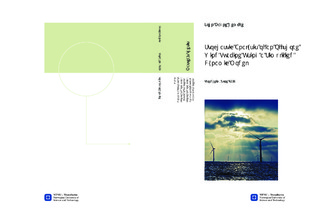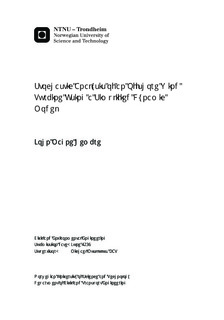| dc.contributor.advisor | Muskulus, Michael | nb_NO |
| dc.contributor.author | Hembre, John Magne | nb_NO |
| dc.date.accessioned | 2014-12-19T11:33:23Z | |
| dc.date.available | 2014-12-19T11:33:23Z | |
| dc.date.created | 2014-08-19 | nb_NO |
| dc.date.issued | 2014 | nb_NO |
| dc.identifier | 739037 | nb_NO |
| dc.identifier | ntnudaim:11504 | nb_NO |
| dc.identifier.uri | http://hdl.handle.net/11250/232924 | |
| dc.description.abstract | The objective of this thesis is to propose and evaluate a simplified dynamic model of a wind turbine. This is done by assuming that the structure behaves linearly, and that a load model based of the mean and variance of simulated rotor thrust, depending linearly on turbulence, is sufficient to estimate the response.The realistic response of the wind turbine is calculated in time domain using the NREL FAST finite element code, whereas the simplified model response are calculated analytically because of the Gaussian behavior of the load model. It is suspected that more sophisticated simplified load models in the future might not be linear, and the response of the simplified system is therefore also calculated using the relatively new probability density evolution method. This is done to assess the general feasibility of using this method to estimate responses of such models. Probability density evolution is performed numerically using the cell-mapping method, and evaluation of the accuracy and performance of these calculations is also a primary object of the thesis. It is also shown how autoregression could be used to incorporate correlated forcing in the cell-mapping method.The wind turbine considered is the NREL 5-MW Baseline turbine, supported by its reference tower.Results show that the response of the proposed simplified dynamic system is too coarse compared to the simulated response distributions. The model seems to overestimate both the mean value and the variance of the true displacements. Possible improvements of the dynamic system, especially of the simplified load model, is evaluated and discussed.The results also show that first order autoregression successfully implements correlated force realizations into the cell-mapping method, and that both Kaimal simulated turbulence and the proposed simplified thrust are processes that could be estimated to a satisfactory degree using first order autoregression. With correlated forcing incorporated through autoregression, probability density evolution is shown to provide accurate estimates of the model response. The method also shows great promise to be useful when considering future simplified models, provided that one could find ways to keep the number of state-space dimensions to a minimum. | nb_NO |
| dc.language | eng | nb_NO |
| dc.publisher | Institutt for bygg, anlegg og transport | nb_NO |
| dc.title | Stochastic Analysis of an Offshore Wind Turbine Using a Simplified Dynamic Model | nb_NO |
| dc.type | Master thesis | nb_NO |
| dc.source.pagenumber | 158 | nb_NO |
| dc.contributor.department | Norges teknisk-naturvitenskapelige universitet, Fakultet for ingeniørvitenskap og teknologi, Institutt for bygg, anlegg og transport | nb_NO |

